Effect of Strain Rate Sensitivity on Fracture of Laminated Rings under Dynamic Compressive Loading
Abstract
:1. Introduction
2. Constitutive Model
3. Problem Formulation and Method of Solution
4. Results and Discussions
4.1. Effects of Number and Location of Layers
4.2. Effects of Volume Fraction
4.3. Effects of Applied Strain Rate
4.4. Fracture Strain Comparison by Shape Factor ()
4.5. Effects of Topological Interface
4.6. Crack Initiation and Propagation
5. Conclusions
- The f–d curves of cladded rings with a different number of layers of rate-sensitive and rate-insensitive material were located between the f–d curves of compressed rings with monolithic material. While the outer wall had a rate-sensitive material, ductility increased by about 25%, when the number of layers decreased from 18 by 18 to 1 by 1.
- Ductility was found to be governed by the behavior of the material located at the outer wall regardless of the volume fraction. This is because crack initiates from the corner of the outer walls. However, as the thickness of the layers decreased and their numbers increased, the difference between having a rate-sensitive or rate-insensitive material at the outer wall was observed less (i.e., the f–d curves became closer to each other).
- The amount of barreling at the outer wall was found to have a direct relationship with ductility. More barreling at the outer wall resulted in higher fracture strain. On the other hand, the advancement in the fracture can be associated with more barreling on the inner surface. Similar to the effect of friction in the ring compression test, the direction of material flow can be affected by material parameters, including strain rate sensitivity parameter as well as the magnitude of dynamic loading. Less barreling was observed when the compression speed increased.
- The effects of the shape factor on the fracture of the compressed rings were evaluated by changing the inner radius. As the shape factor increased, the role of the location of the rate-sensitive material became less remarkable. Moreover, fracture occurred at less force per unit volume for the narrower rings.
- The effect of the topology of the material at the interface of rate-sensitive and rate-insensitive materials in the ring was investigated. Differences in bonding types (e.g., layered or noise diffusion) did not substantially affect the crack initiation because the interface was away from the outer corners. However, crack propagation was quicker in the case of the noise diffusion interface. This behavior may be more suitable in numerical simulations of the interface of FGMs, as it was also experimentally observed by Gang et al. [36] that crack grows quickly across compressed rings.
- Delamination-like behavior or crack branching can be a function of layer thickness and strain rate. As layer thickness increased, more delamination or crack branching was observed at the interface of the laminated layers. Furthermore, at high strain rates, less delamination and change in the direction of the fracture path was observed.
Author Contributions
Funding
Institutional Review Board Statement
Informed Consent Statement
Data Availability Statement
Conflicts of Interest
References
- Winter, T.C.; Neu, R.W.; Singh, P.M.; Kolaya, L.E.; Deo, C.S. Fretting wear comparison of cladding materials for reactor fuel cladding application. J. Nucl. Mater. 2018, 508, 505–515. [Google Scholar]
- Torres, H.; Vuchkov, T.; Ripoll, M.R.; Prakash, B. Tribological behaviour of MoS2-based self-lubricating laser cladding for use in high temperature applications. Tribol. Int. 2018, 126, 153–165. [Google Scholar] [CrossRef]
- Meng, L.; Zhao, W.; Hou, K.; Kou, D.; Yuan, Z.; Zhang, X.; Xu, J.; Hu, Q.; Wang, D.; Zeng, X. A comparison of microstructure and mechanical properties of laser cladding and laser-induction hybrid cladding coatings on full-scale rail. Mater. Sci. Eng. A 2019, 748, 1–15. [Google Scholar] [CrossRef]
- Chen, X.; Wu, P.; Embury, J.; Huang, Y. Enhanced ductility in round tensile bars produced by cladding a ductile ring. Model. Simul. Mater. Sci. Eng. 2010, 18, 025005. [Google Scholar] [CrossRef]
- Clifton, R.J. Stress wave propagation, dynamic material response, and quantitative non-destructive evaluation. Appl. Mech. Rev. 1985, 38, 1276–1278. [Google Scholar] [CrossRef]
- Bax, B.; Rajput, R.; Kellet, R.; Reisacher, M. Systematic evaluation of process parameter maps for laser cladding and directed energy deposition. Addit. Manuf. 2018, 21, 487–494. [Google Scholar] [CrossRef]
- Fujishima, M.; Oda, Y.; Ashida, R.; Takezawa, K.; Kondo, M. Study on factors for pores and cladding shape in the deposition processes of Inconel 625 by the directed energy deposition (DED) method. CIRP J. Manuf. Sci. Technol. 2017, 19, 200–204. [Google Scholar] [CrossRef]
- Bajaj, P.; Hariharan, A.; Kini, A.; Kürnsteiner, P.; Raabe, D.; Jägle, E.A. Steels in additive manufacturing: A review of their microstructure and properties. Mater. Sci. Eng. A 2020, 772, 138633. [Google Scholar] [CrossRef]
- Eidelpes, E.; Ibarra, L.F.; Medina, R.A. Ring compression tests on un-irradiated nuclear fuel rod cladding considering fuel pellet support. J. Nucl. Mater. 2018, 510, 446–459. [Google Scholar] [CrossRef]
- Herb, J.; Sievers, J.; Sonnenburg, H.-G. A new cladding embrittlement criterion derived from ring compression tests. Nucl. Eng. Des. 2014, 273, 615–630. [Google Scholar] [CrossRef]
- Shi, Y.; Wu, P.; Lloyd, D.; Li, D. Effect of rate sensitivity on necking behavior of a laminated tube under dynamic loading. J. Appl. Mech. 2014, 81, 051010. [Google Scholar] [CrossRef]
- Weber, G.; Anand, L. Finite deformation constitutive equations and a time integration procedure for isotropic, hyperelastic-viscoplastic solids. Comput. Methods Appl. Mech. Eng. 1990, 79, 173–202. [Google Scholar] [CrossRef]
- Hu, X.; Wu, P.; Lloyd, D.; Embury, J. Enhanced formability in sheet metals produced by cladding a high strain-rate sensitive layer. J. Appl. Mech. 2014, 81, 021007. [Google Scholar] [CrossRef]
- Chen, X.; Wu, P.; Lloyd, D.; Embury, J.; Huang, Y. Enhanced ductility in sheet metals produced by cladding a ductile layer. J. Appl. Mech. Mater. 2010, 77, 041015. [Google Scholar] [CrossRef]
- Lonetti, P. Dynamic propagation phenomena of multiple delaminations in composite structures. Comput. Mater. Sci. 2010, 48, 563–575. [Google Scholar] [CrossRef]
- Funari, M.F.; Greco, F.; Lonetti, P. Dynamic debonding in layered structures: A coupled ALE-cohesive approach. Frat. Ed. Integrita Strutt. 2017, 11, 524–535. [Google Scholar] [CrossRef] [Green Version]
- Groover, M.P. Fundamentals of Modern Manufacturing: Materials, Processes, and Systems; John Wiley & Sons: Hoboken, NJ, USA, 2020. [Google Scholar]
- Sofuoglu, H.; Rasty, J. On the measurement of friction coefficient utilizing the ring compression test. Tribol. Int. 1999, 32, 327–335. [Google Scholar] [CrossRef]
- Fan, X.; Dong, Y.; Yang, H.; Gao, P.; Zhan, M. Friction assessment in uniaxial compression test: A new evaluation method based on local bulge profile. J. Mater. Process. Technol. 2017, 243, 282–290. [Google Scholar] [CrossRef]
- Partovi, A.; Shahzamanian, M.; Wu, P. Study of influence of superimposed hydrostatic pressure on ductility in ring compression test. J. Mater. Eng. Perform. 2020, 29, 6581–6590. [Google Scholar] [CrossRef]
- Ghorbani, A.; Zarei-Hanzaki, A.; Nezhadfar, P.D.; Maghsoudi, M.H. Microstructural evolution and room temperature mechanical properties of AZ31 alloy processed through hot constrained compression. Int. J. Adv. Manuf. Technol. 2019, 102, 2307–2317. [Google Scholar] [CrossRef]
- Shahzamanian, M. Anisotropic Gurson-Tvergaard-Needleman plasticity and damage model for finite element analysis of elastic-plastic problems. Int. J. Numer. Methods Eng. 2018, 115, 1527–1551. [Google Scholar] [CrossRef]
- Partovi, A.; Shahzamanian, M.; Wu, P. Numerical study of mechanical behaviour of tubular structures under dynamic compression. J. Mech. Sci. Technol. 2021, 35, 1129–1142. [Google Scholar] [CrossRef]
- Shahzamanian, M.; Lloyd, D.; Wu, P. Enhanced bendability in sheet metal produced by cladding a ductile layer. Mater. Today Commun. 2020, 23, 100952. [Google Scholar] [CrossRef]
- Wierzbicki, T.; Bao, Y.; Lee, Y.-W.; Bai, Y. Calibration and evaluation of seven fracture models. Int. J. Mech. Sci. 2005, 47, 719–743. [Google Scholar] [CrossRef]
- Brar, N.; Joshi, V.; Harris, B. Constitutive Model Constants for Al7075-t651 and Al7075-t6; Aip conference proceedings; American Institute of Physics: Nashville, TN, USA, 2009; pp. 945–948. [Google Scholar]
- Murugesan, M.; Jung, D.W. Johnson Cook material and failure model parameters estimation of AISI-1045 medium carbon steel for metal forming applications. Materials 2019, 12, 609. [Google Scholar] [CrossRef] [Green Version]
- Wang, K. Calibration of the Johnson-Cook Failure Parameters as the Chip Separation Criterion in the Modelling of the Orthogonal Metal Cutting Process. Master’s Thesis, McMaster University, Burlington, ON, Canada, 2016. [Google Scholar]
- Dunand, M.; Mohr, D. Effect of Lode parameter on plastic flow localization after proportional loading at low stress triaxialities. J. Mech. Phys. Solids 2014, 66, 133–153. [Google Scholar] [CrossRef]
- Johnson, G.R. A constitutive model and data for materials subjected to large strains, high strain rates, and high temperatures. In Proceedings of the Seventh International Symposium on Ballistics, The Hague, The Netherlands, 19–21 April 1983; pp. 541–547. [Google Scholar]
- Systèmes, D. Simulation of the ballistic perforation of aluminum plates with Abaqus/Explicit. Abaqus Technol. Brief. 2012. Available online: https://www.3ds.com/fileadmin/PRODUCTS-SERVICES/SIMULIA/RESOURCES/aero-ballistic-perforation-alumnium-plates-12.pdf (accessed on 15 January 2020).
- Cheng, W.; Outeiro, J.; Costes, J.P.; M’Saoubi, R.; Karaouni, H.; Astakhov, V. A constitutive model for Ti6Al4V considering the state of stress and strain rate effects. Mech. Mater. 2019, 137, 103103. [Google Scholar] [CrossRef] [Green Version]
- Hibbitt, D.; Karlsson, B.; Sorensen, P. ABAQUS User-Manual Release 6.14; Dassault Systèmes Simulia Corp.: Providence, RI, USA, 2014. [Google Scholar]
- Lesuer, D.R.; Kay, G.; LeBlanc, M. Modeling Large-Strain, High-Rate Deformation in Metals; Lawrence Livermore National Lab.: Livermore, CA, USA, 2001.
- Hartley, P.; Sturgess, C.; Lees, A.; Rowe, G. The static axial compression of tall hollow cylinders with high interfacial friction. Int. J. Mech. Sci. 1981, 23, 473–485. [Google Scholar] [CrossRef]
- Gang, L.; Wang, L.-L.; Yuan, S.-J.; Wang, Z.-R. Compressive formability of 7075 aluminum alloy rings under hydrostatic pressure. Trans. Nonferrous Met. Soc. China 2006, 16, 1103–1109. [Google Scholar]
- Syn, C.; Lesuer, D.; Wolfenstine, J.; Sherby, O. Layer thickness effect on ductile tensile fracture. Metall. Trans. A 1993, 24, 1647–1653. [Google Scholar] [CrossRef]
- Shahzamanian, M.; Partovi, A.; Wu, P. Finite element analysis of elastic–plastic and fracture behavior in functionally graded materials (FGMs). SN Appl. Sci. 2020, 2, 1–11. [Google Scholar] [CrossRef]
- Ohashi, Y.; Wolfenstine, J.; Koch, R.; Sherby, O. Fracture behavior of a laminated steel-brass composite in bend tests. Mater. Sci. Eng. A 1992, 151, 37–44. [Google Scholar] [CrossRef]
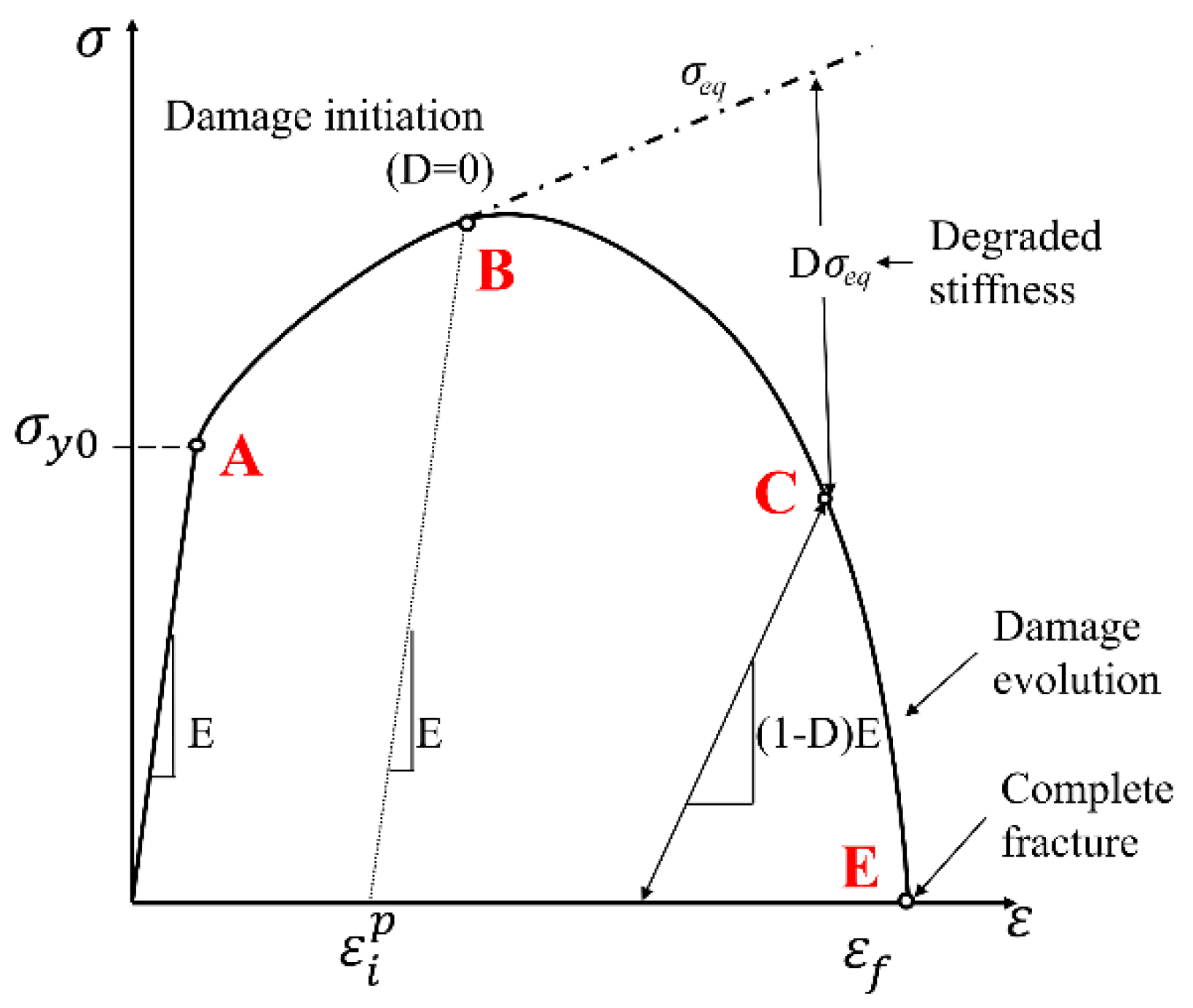
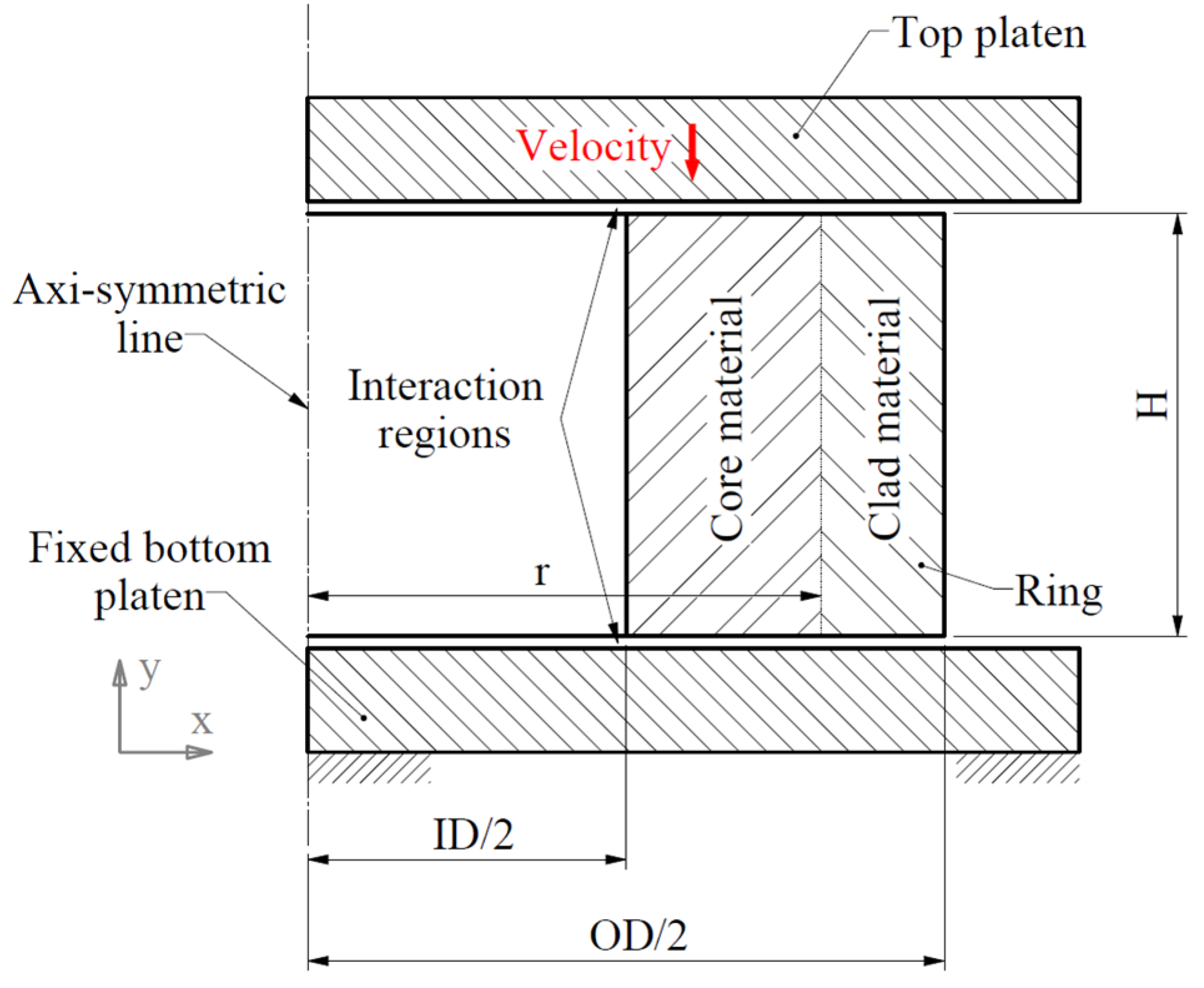
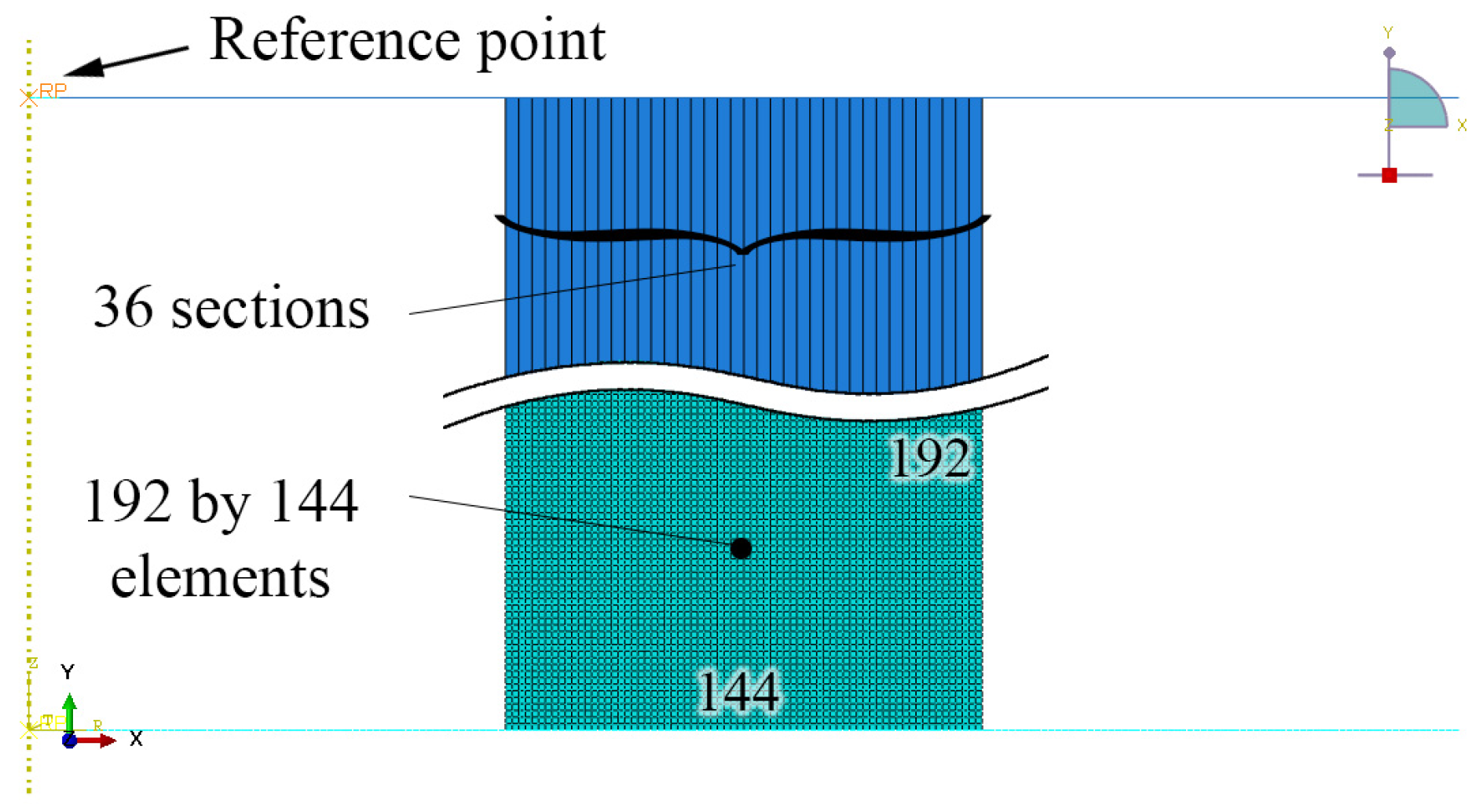



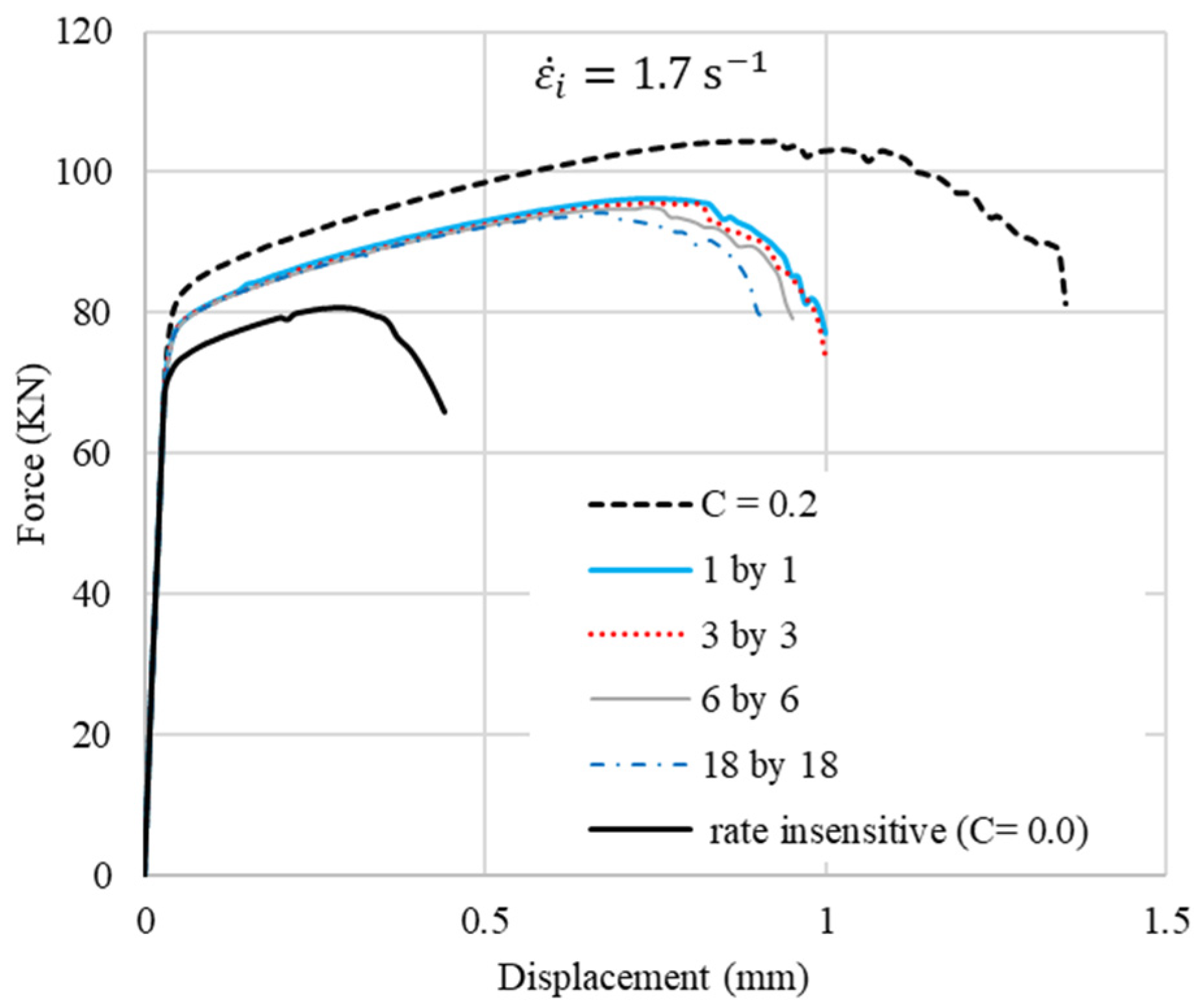
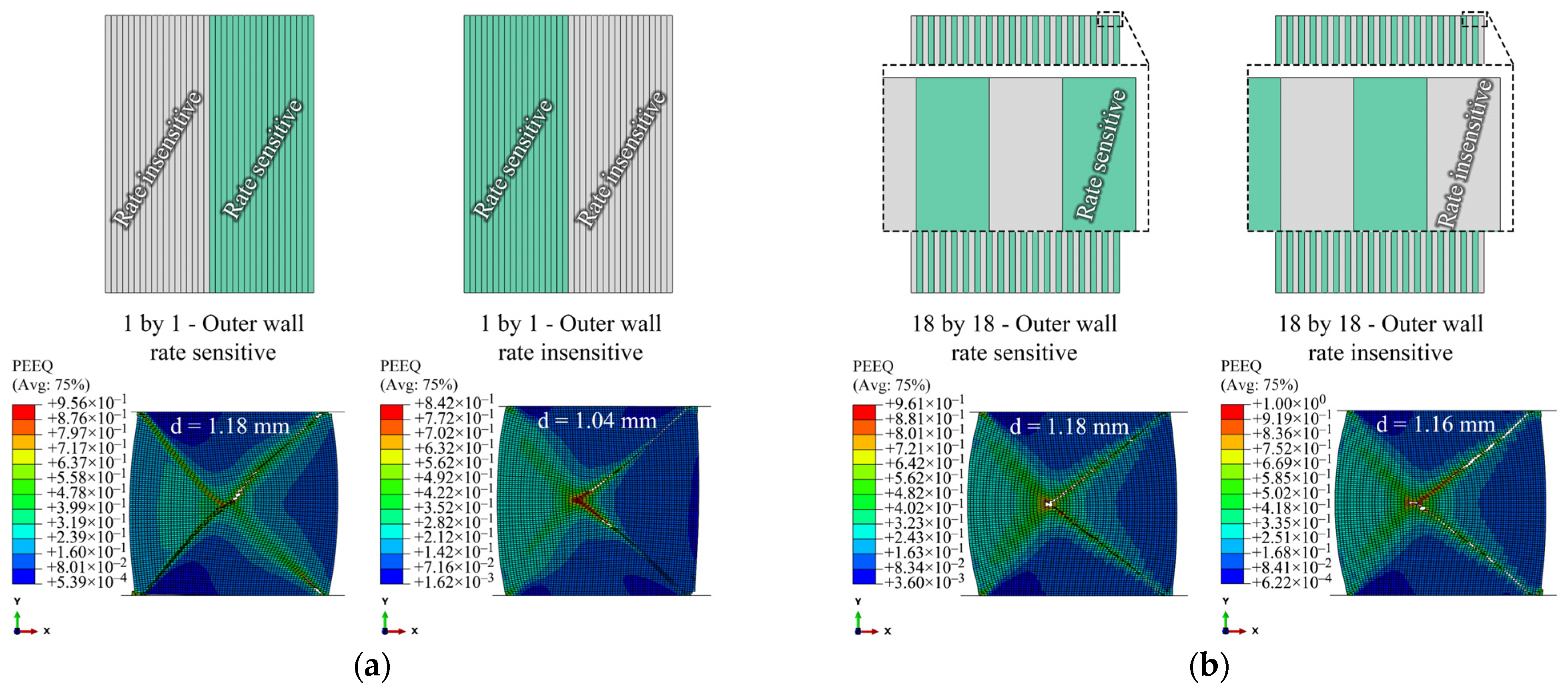
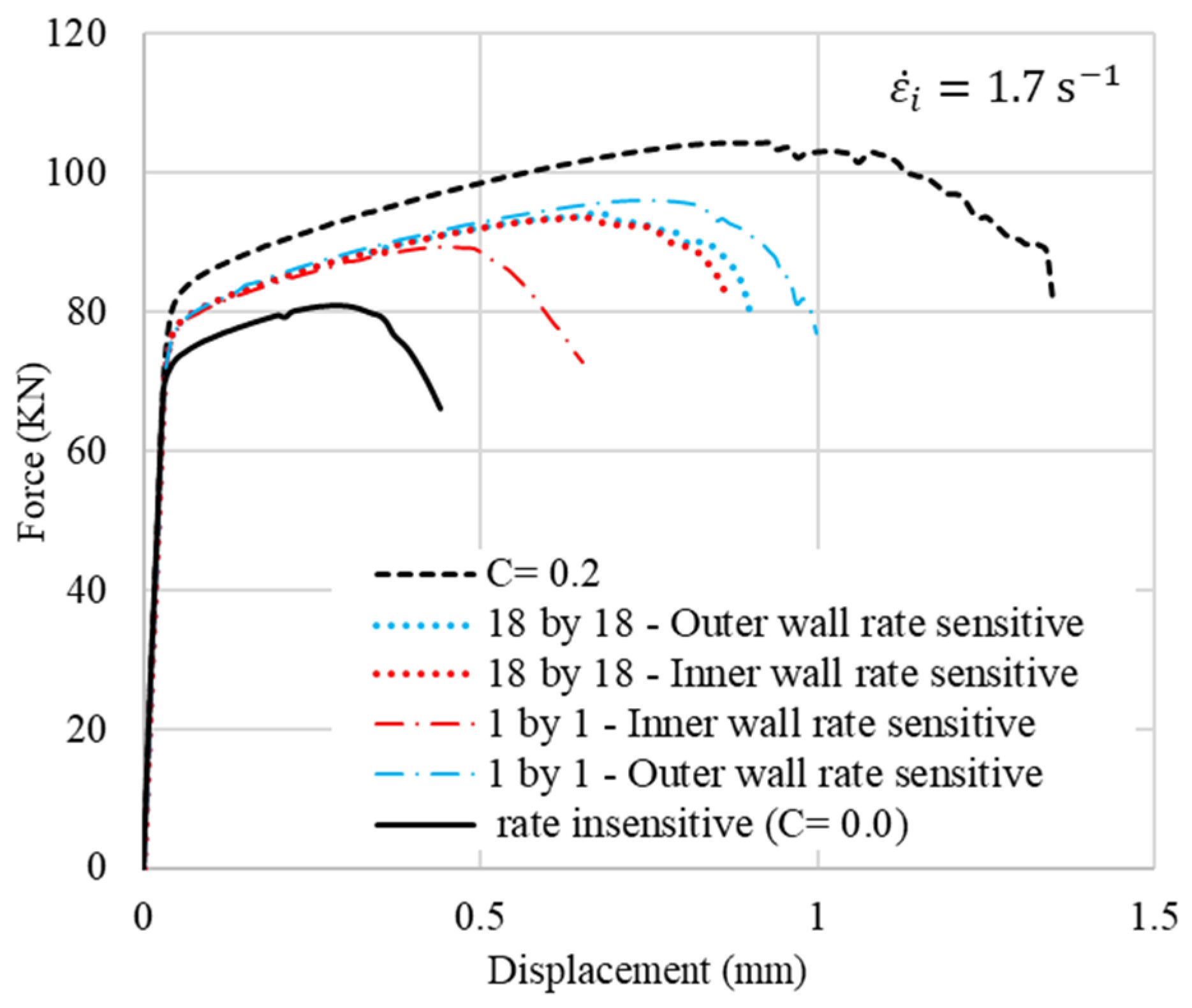
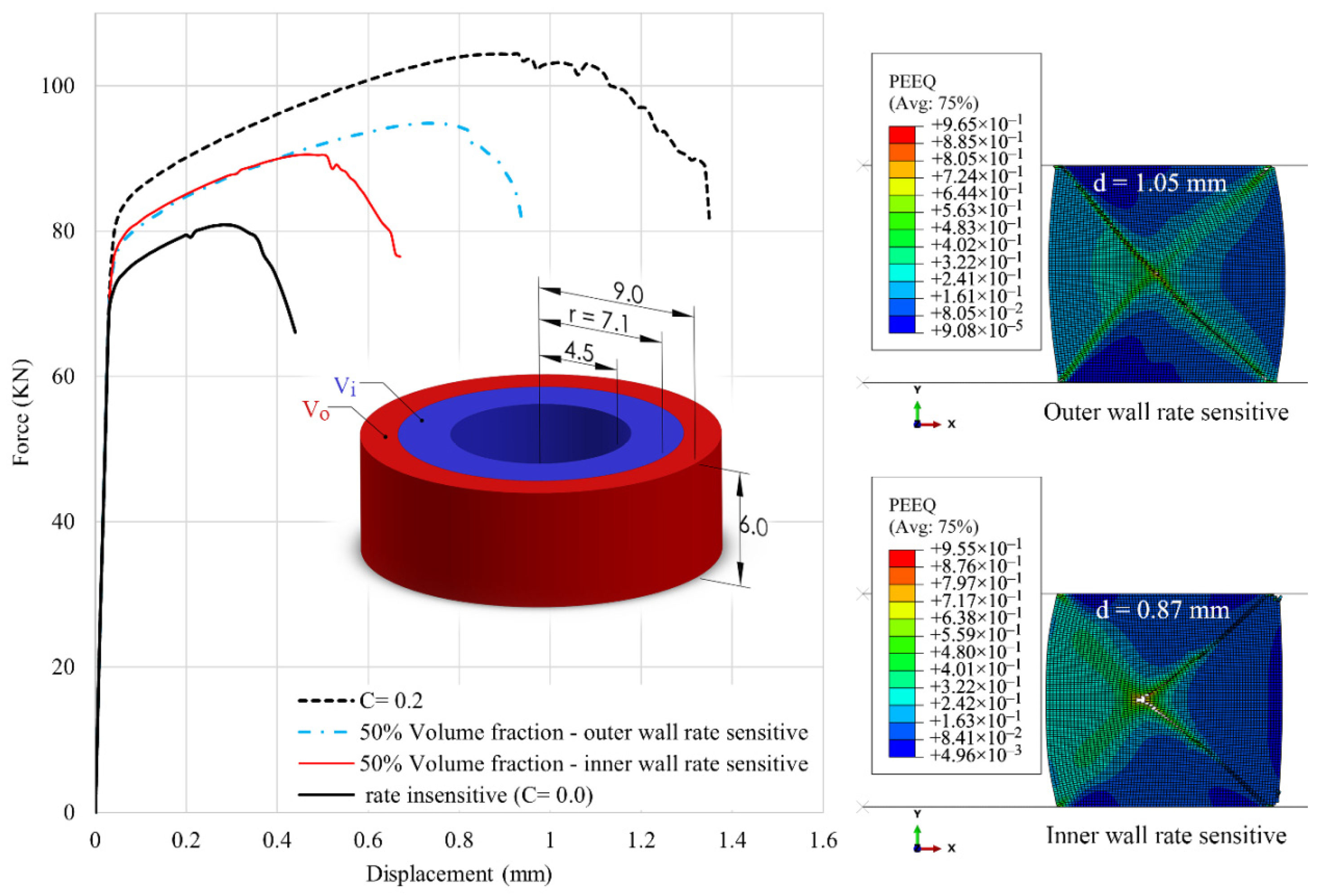
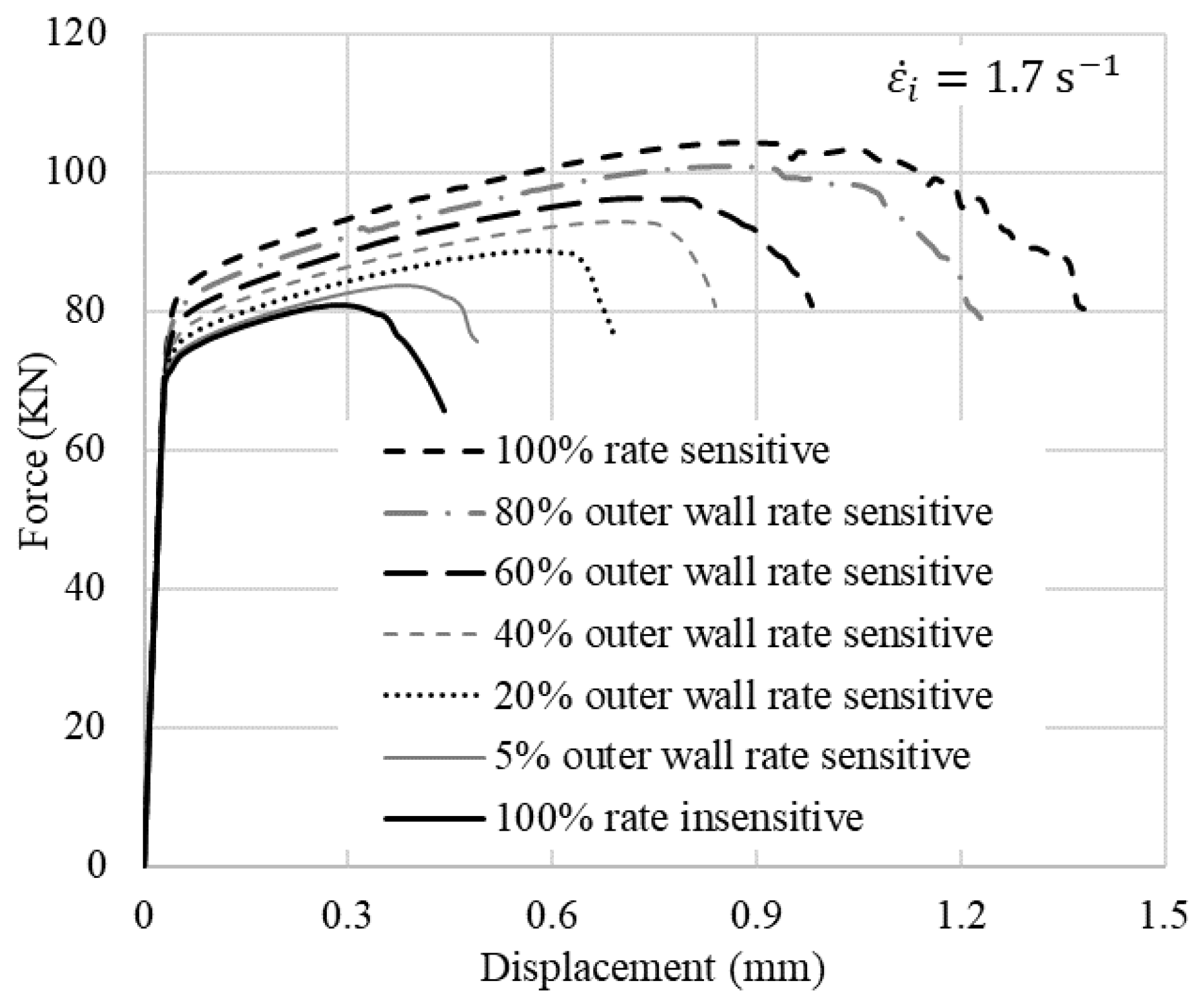
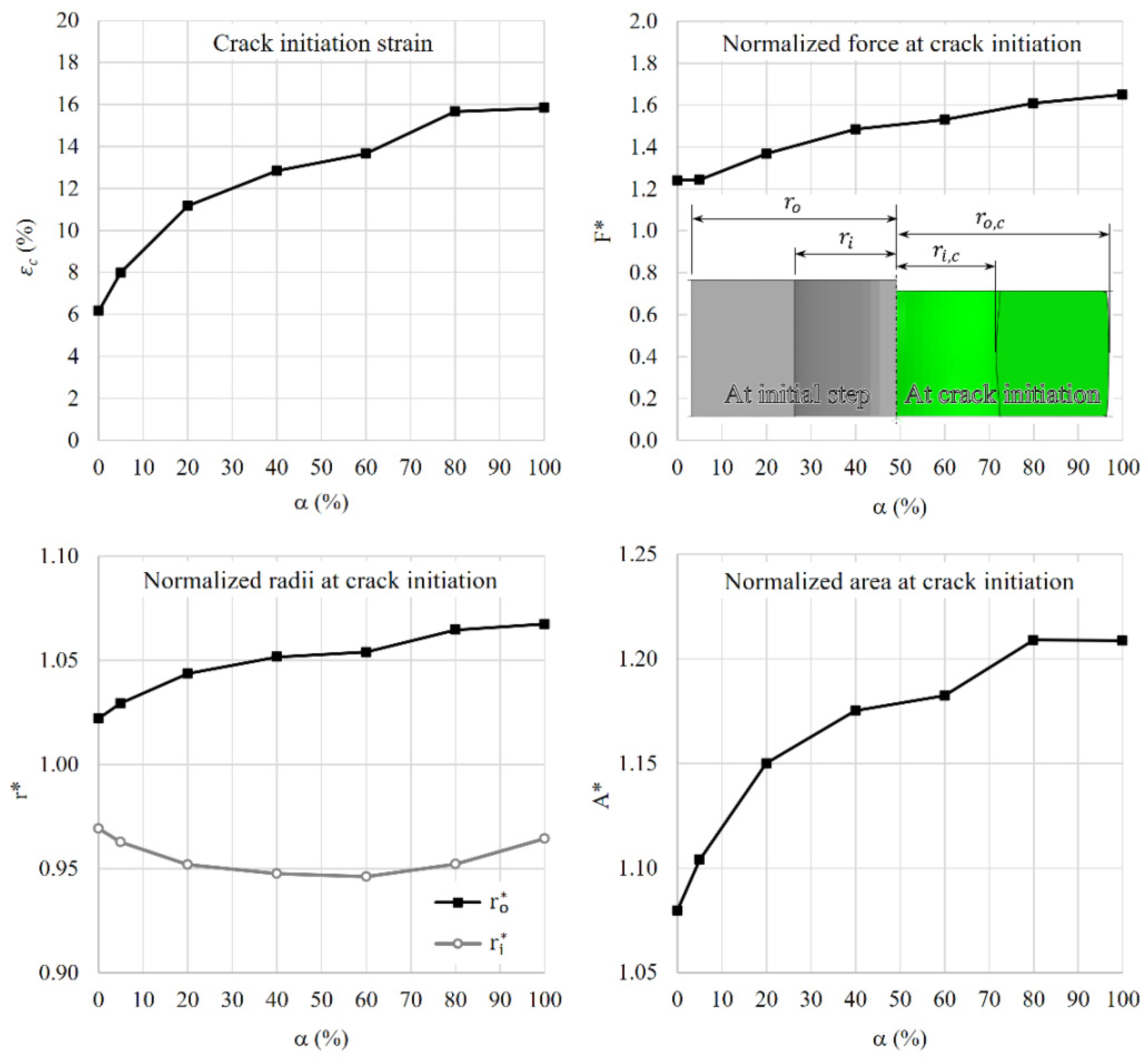
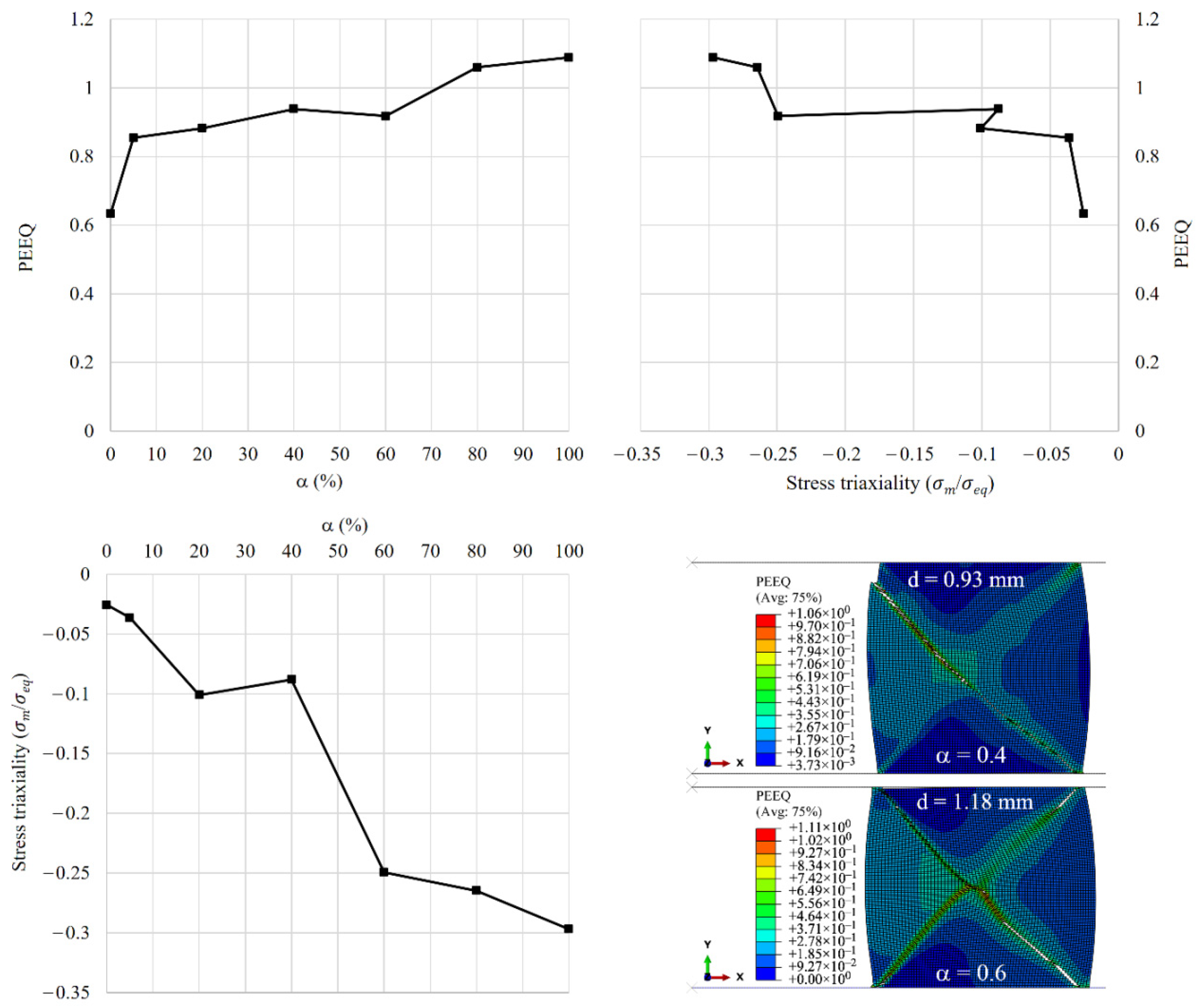
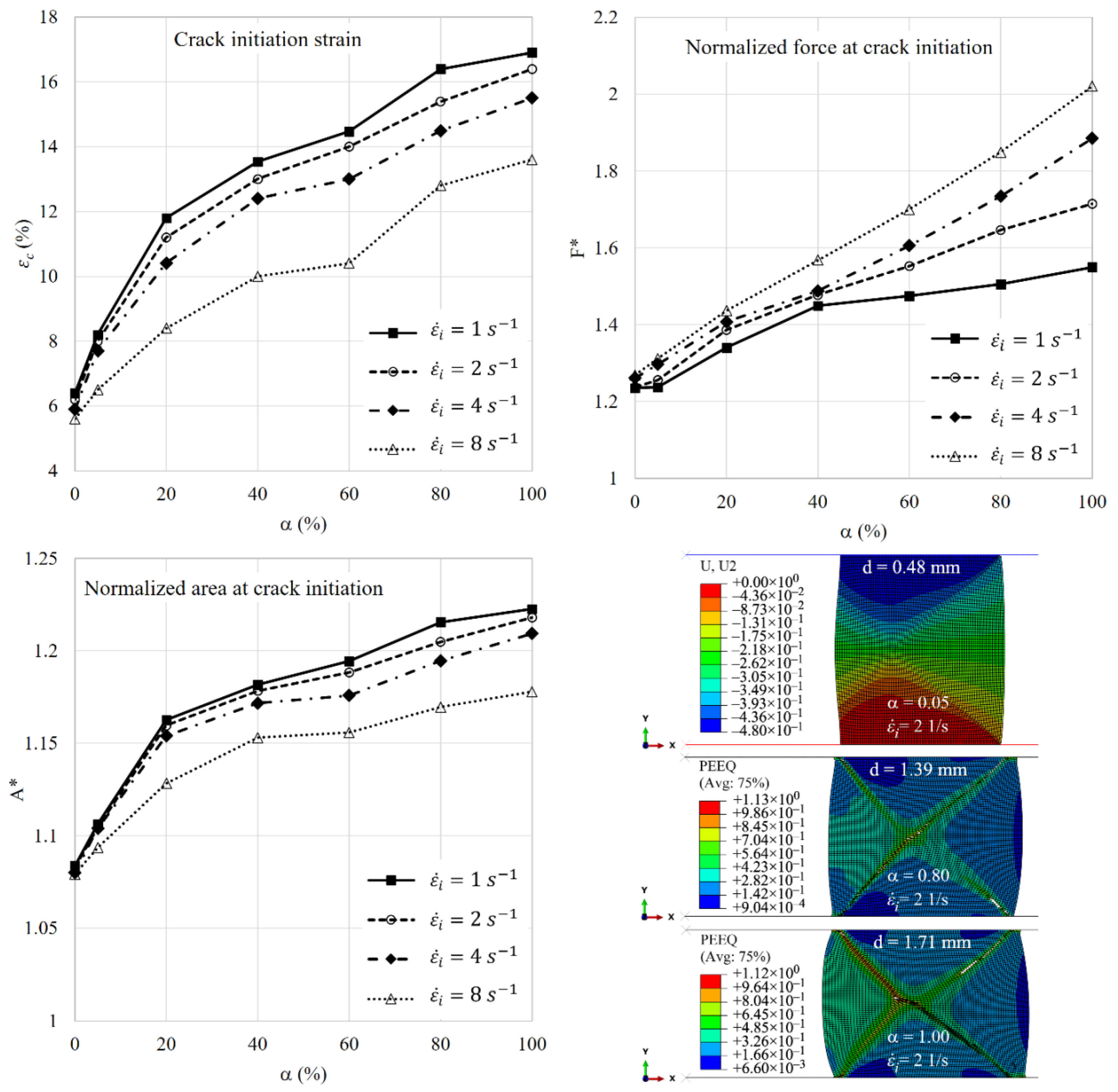
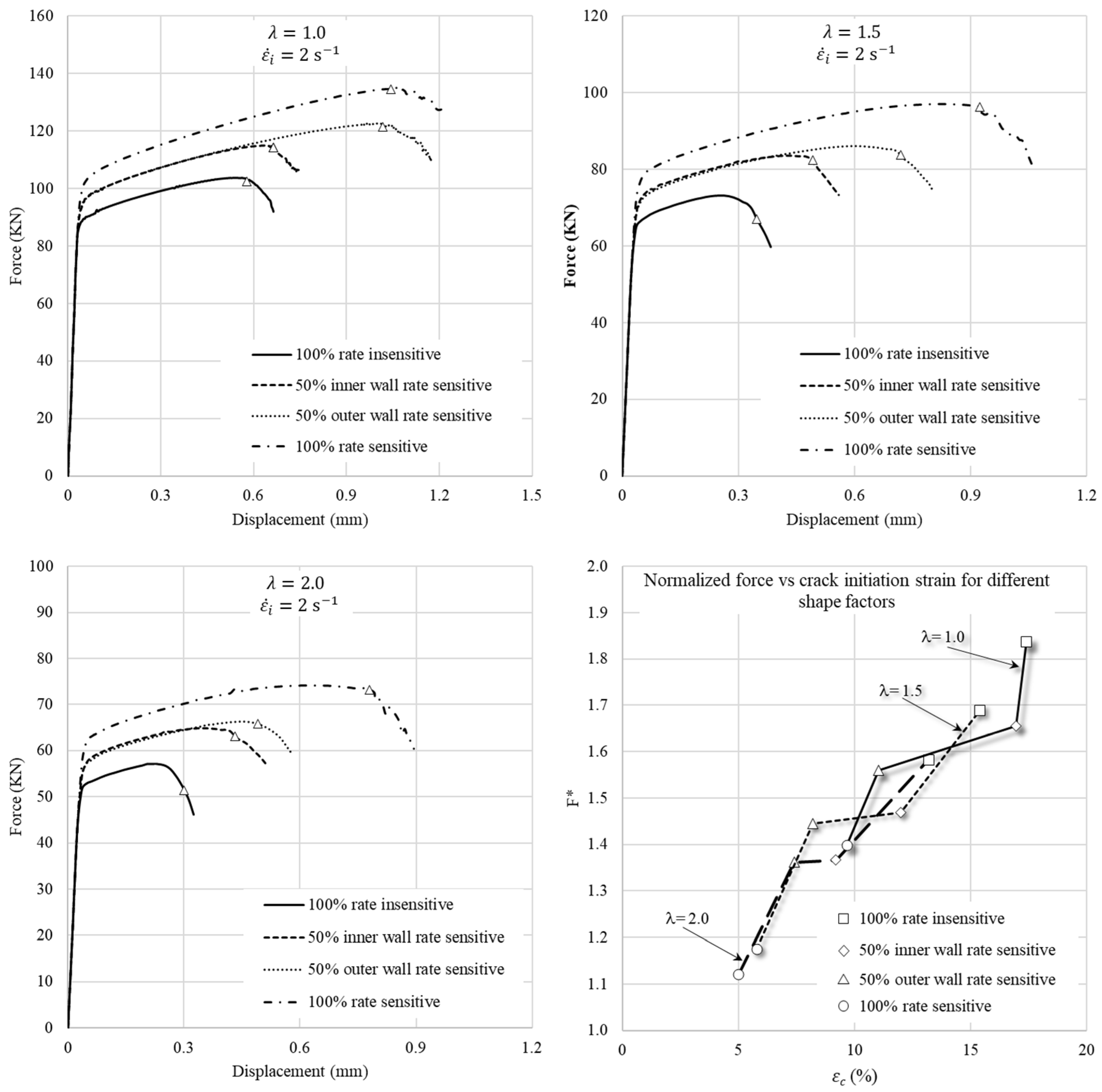
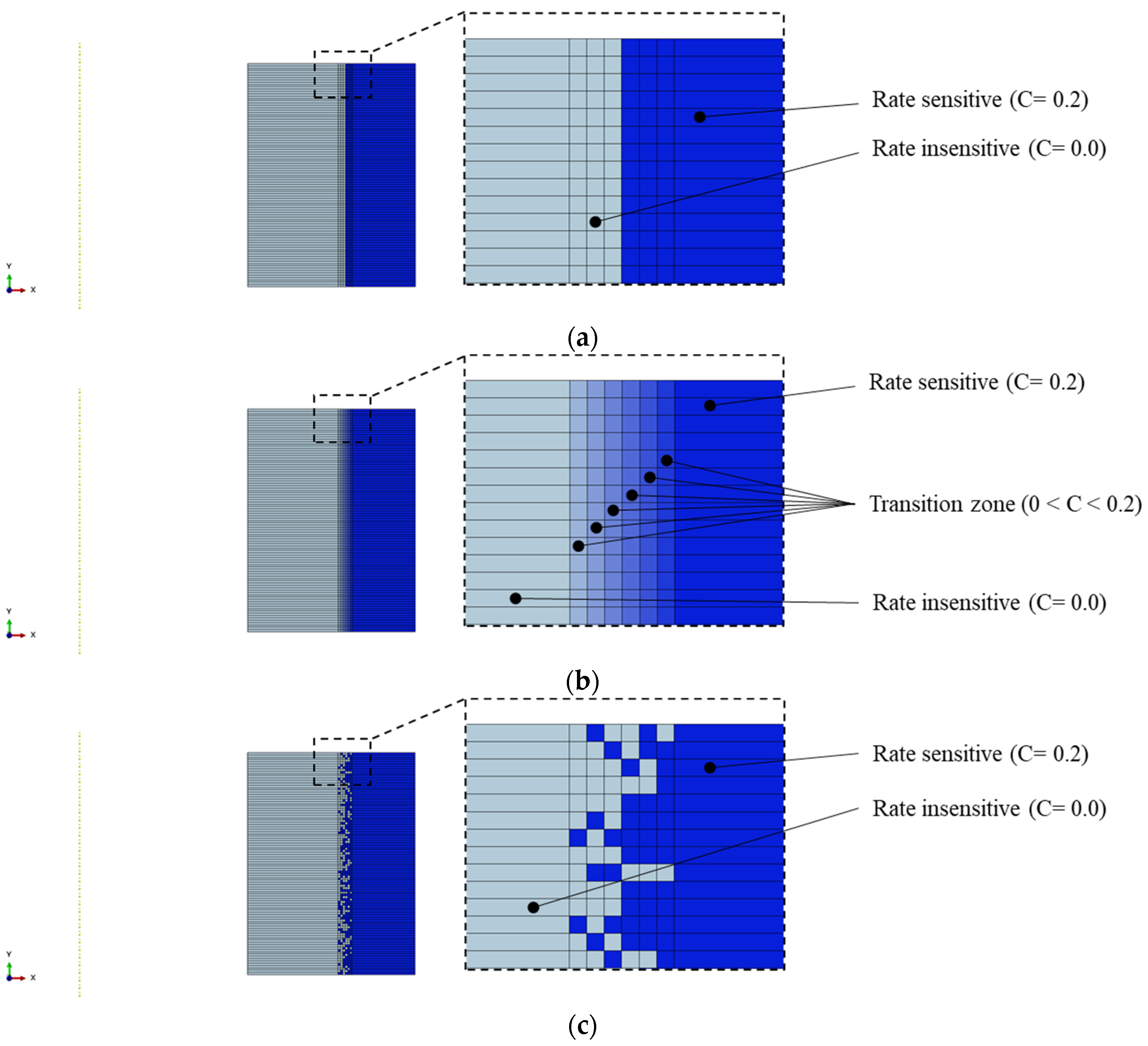
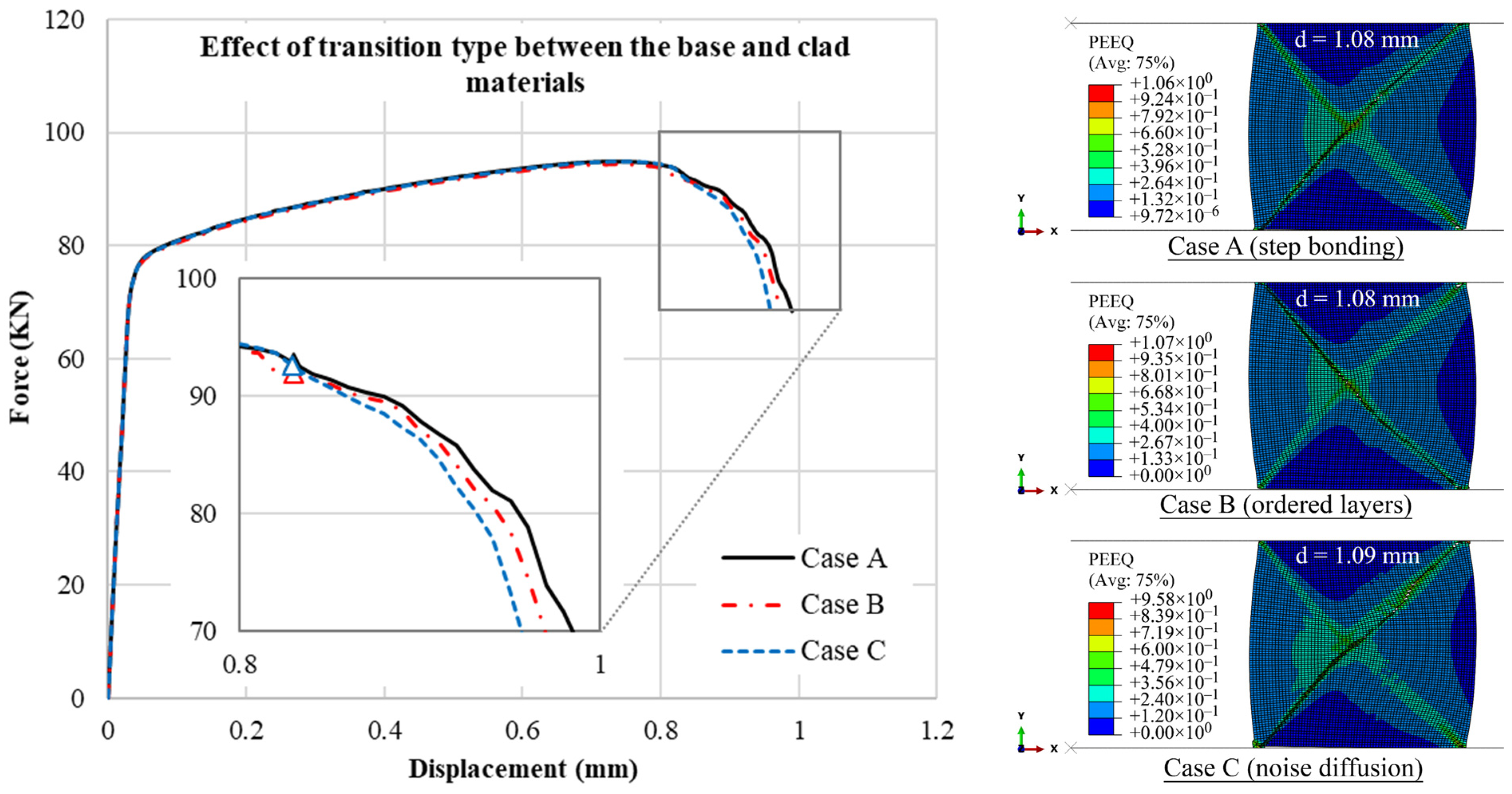

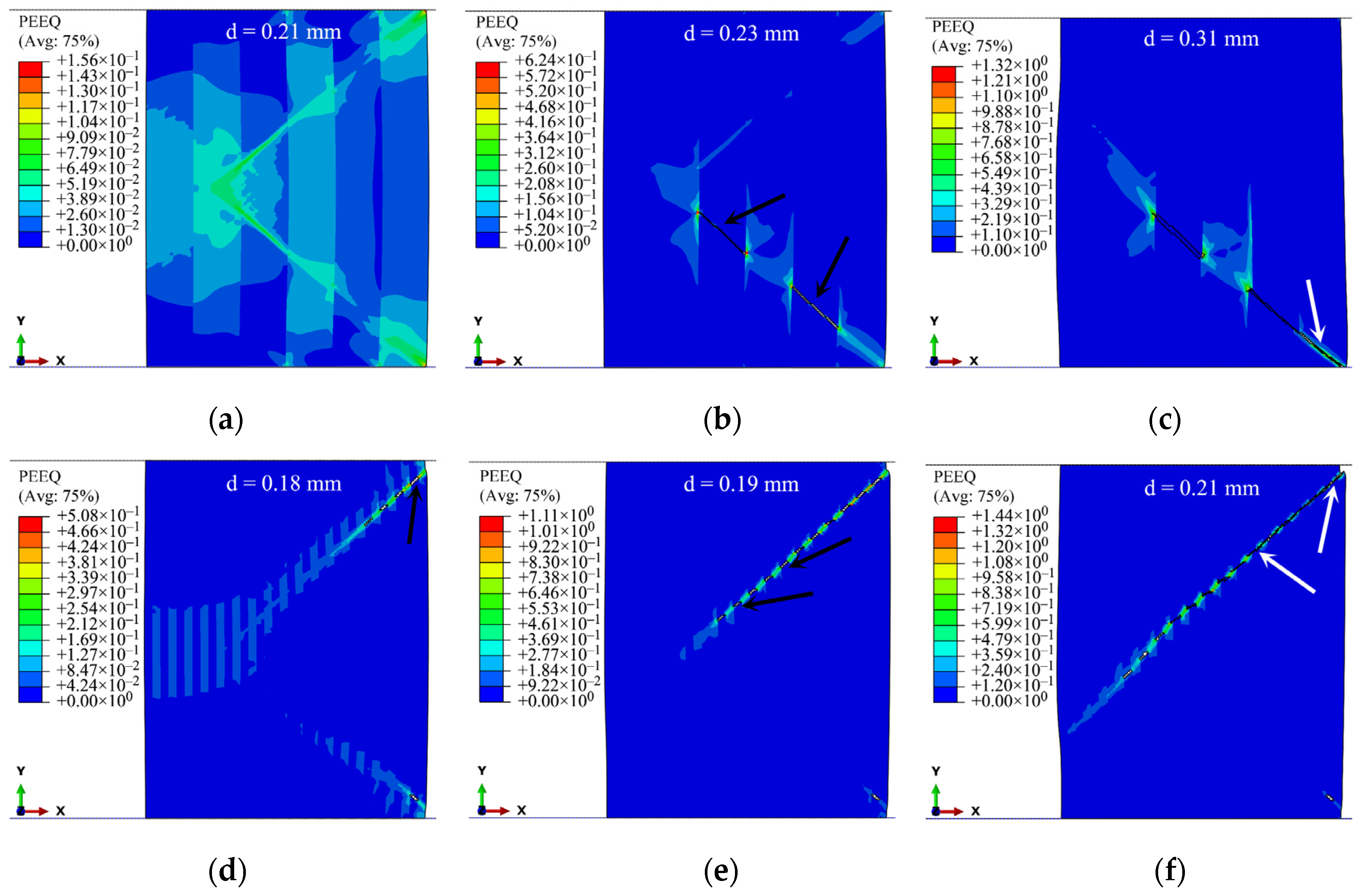

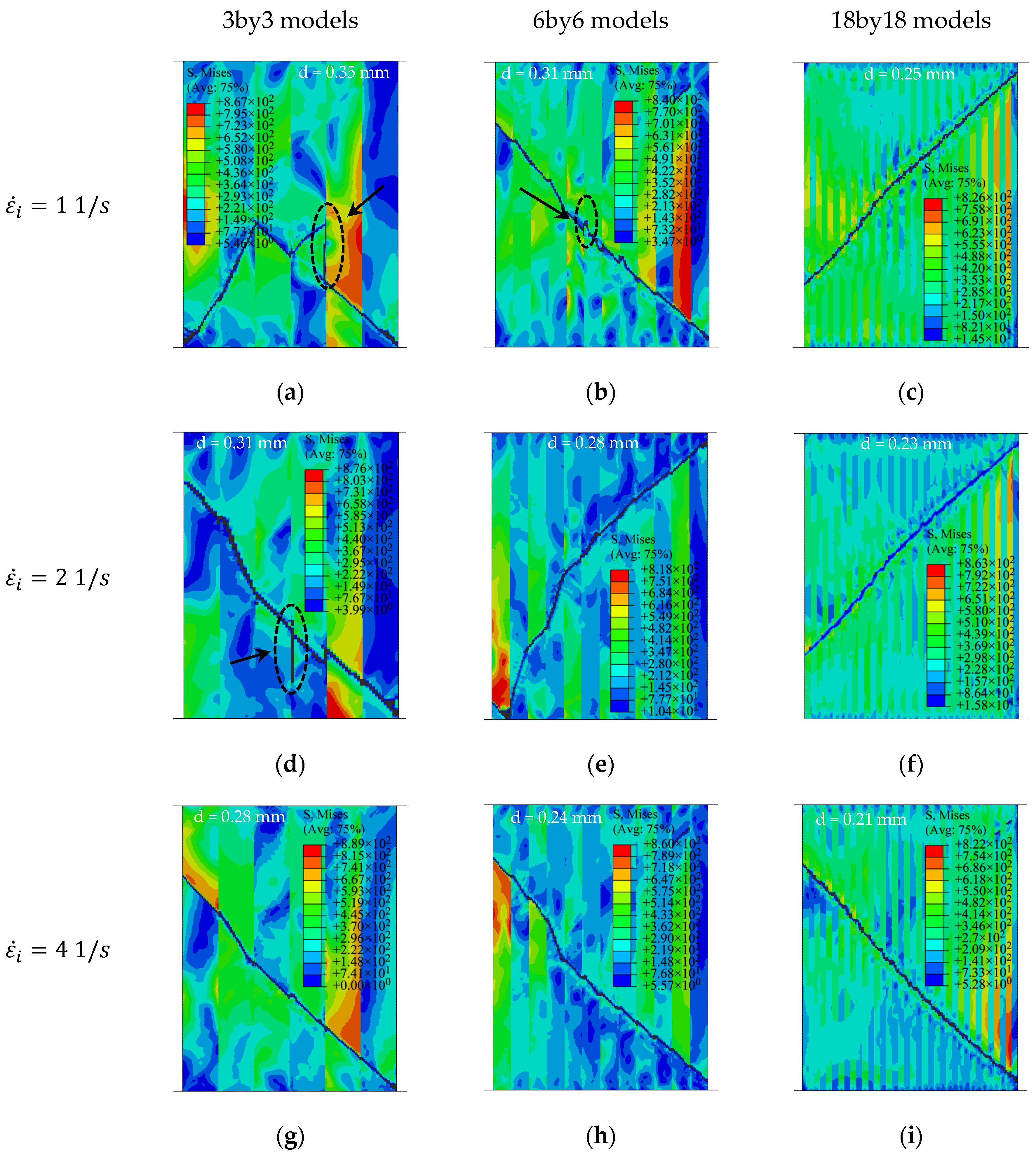
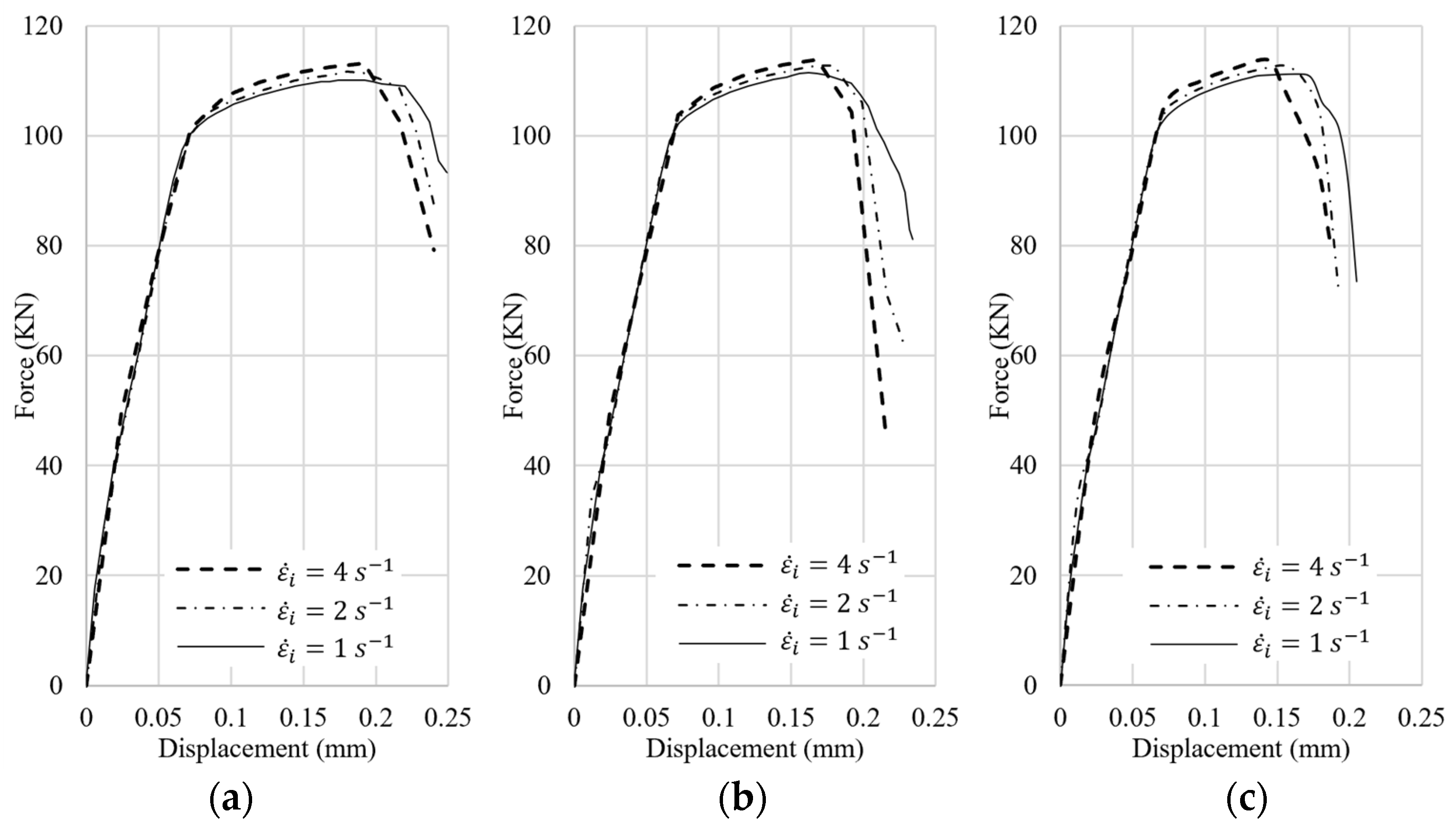
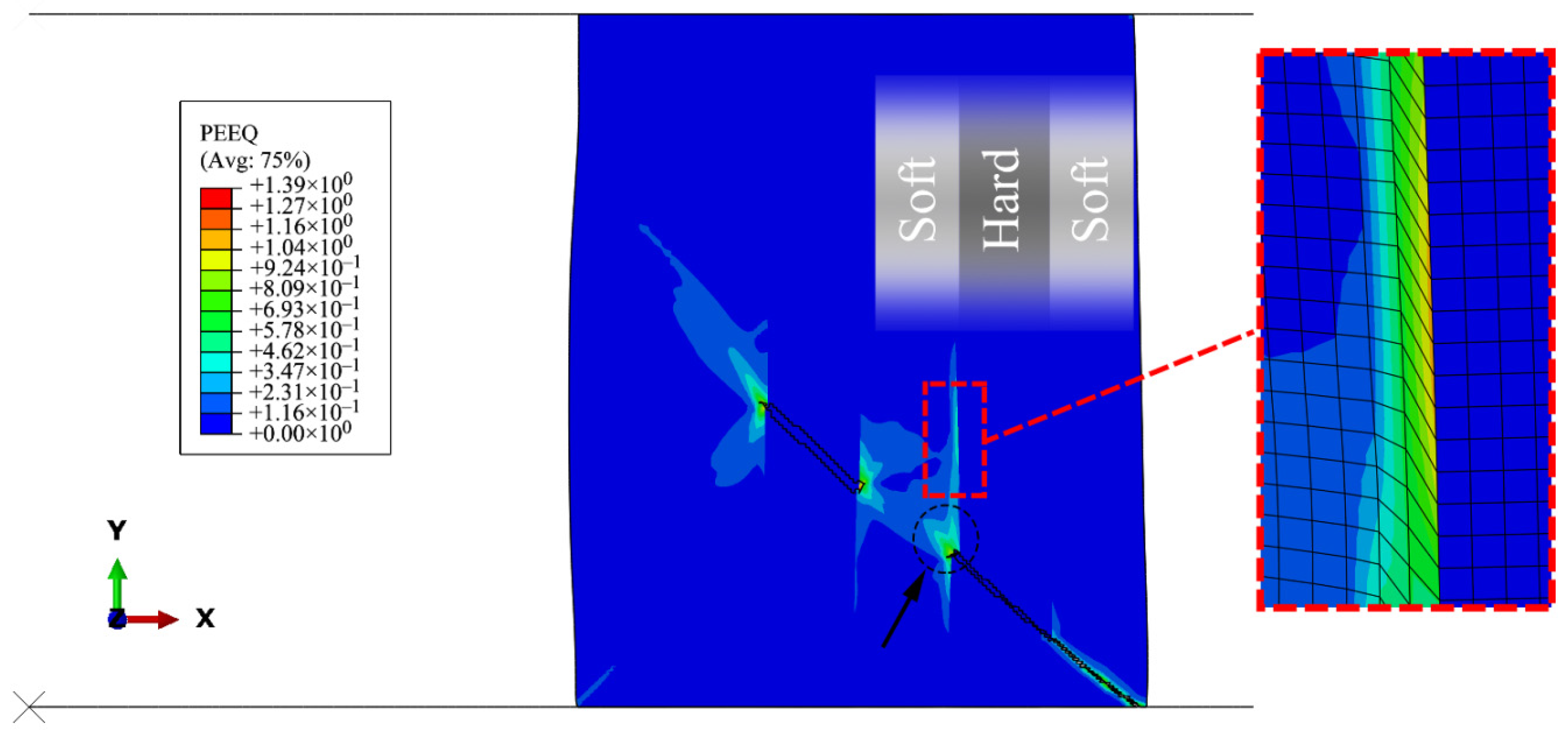
| A (MPa) | B (MPa) | n | C | m | Tm (K) | T0 (K) | |
|---|---|---|---|---|---|---|---|
| 324 | 114 | 0.42 | 0.002 | 1.34 | 1.0 | 925 | 293.2 |
| D1 | D2 | D3 | D4 | D5 |
|---|---|---|---|---|
| −0.77 | 1.45 | −0.47 | 0.00 | 1.60 |
| D1 | D2 | D3 | D4 | D5 | |
|---|---|---|---|---|---|
| Clad | −1.77 | 0.45 | 1.47 | 0.00 | 1.60 |
| Base | −1.77 | 1.42 | 0.49 | 0.00 | 1.60 |
Publisher’s Note: MDPI stays neutral with regard to jurisdictional claims in published maps and institutional affiliations. |
© 2022 by the authors. Licensee MDPI, Basel, Switzerland. This article is an open access article distributed under the terms and conditions of the Creative Commons Attribution (CC BY) license (https://creativecommons.org/licenses/by/4.0/).
Share and Cite
Partovi, A.; Shahzamanian, M.M.; Wu, P. Effect of Strain Rate Sensitivity on Fracture of Laminated Rings under Dynamic Compressive Loading. Materials 2022, 15, 472. https://doi.org/10.3390/ma15020472
Partovi A, Shahzamanian MM, Wu P. Effect of Strain Rate Sensitivity on Fracture of Laminated Rings under Dynamic Compressive Loading. Materials. 2022; 15(2):472. https://doi.org/10.3390/ma15020472
Chicago/Turabian StylePartovi, Amir, Mohammad Mehdi Shahzamanian, and Peidong Wu. 2022. "Effect of Strain Rate Sensitivity on Fracture of Laminated Rings under Dynamic Compressive Loading" Materials 15, no. 2: 472. https://doi.org/10.3390/ma15020472






